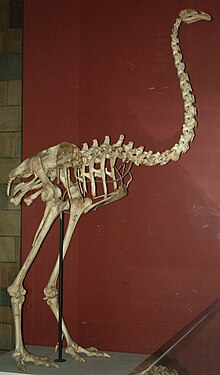| Dinornis Temporal range: Late Pleistocene-Holocene
| |
|---|---|

| |
| D. novaezealandiae, Natural History Museum of London | |
Extinct (c. 1500)
| |
| Scientific classification | |
| Domain: | Eukaryota |
| Kingdom: | Animalia |
| Phylum: | Chordata |
| Class: | Aves |
| Infraclass: | Palaeognathae |
| Order: | †Dinornithiformes |
| Family: | †Dinornithidae |
| Genus: | †Dinornis Owen, 1843[1] |
| Species | |
|
D. novaezealandiae North Island giant moa | |
| Synonyms | |
| |
The giant moa (Dinornis) is an extinct genus of birds belonging to the moa family. As with other moa, it was a member of the order Dinornithiformes. It was endemic to New Zealand. Two species of Dinornis are considered valid, the North Island giant moa (Dinornis novaezealandiae) and the South Island giant moa (Dinornis robustus). In addition, two further species (new lineage A and lineage B) have been suggested based on distinct DNA lineages.[2]
- ^ Checklist Committee Ornithological Society of New Zealand (2010). "Checklist-of-Birds of New Zealand, Norfolk and Macquarie Islands and the Ross Dependency, Antarctica" (PDF). Te Papa Press. Retrieved 4 January 2016.
- ^ Baker, A. J.; Huynen, L. J.; Haddrath, O.; Millar, C. D.; Lambert, D. M. (2005). "Reconstructing the tempo and mode of evolution in an extinct clade of birds with ancient DNA: The giant moas of New Zealand". Proceedings of the National Academy of Sciences. 102 (23): 8257–62. Bibcode:2005PNAS..102.8257B. doi:10.1073/pnas.0409435102. PMC 1149408. PMID 15928096.